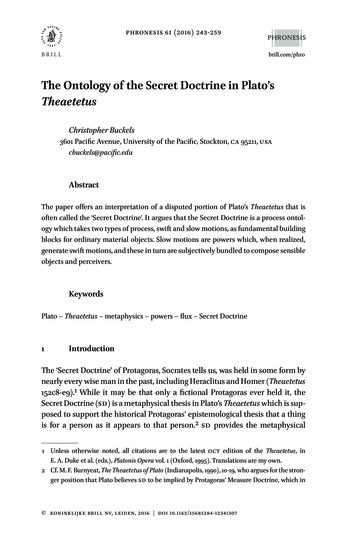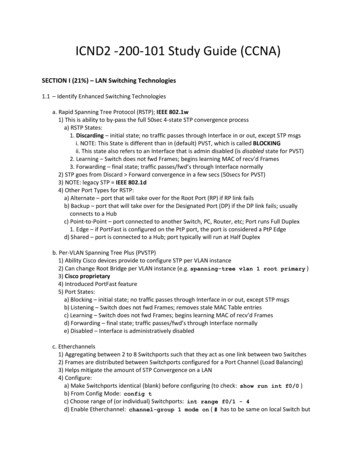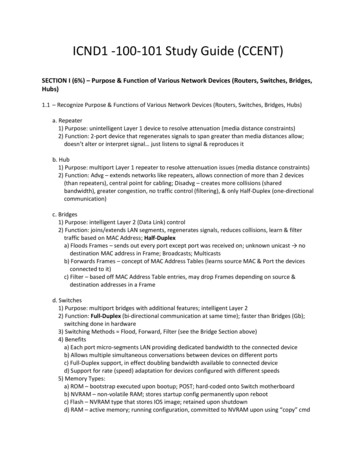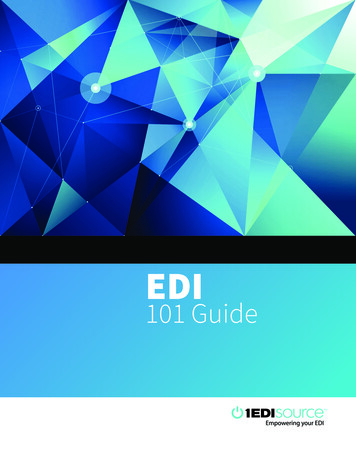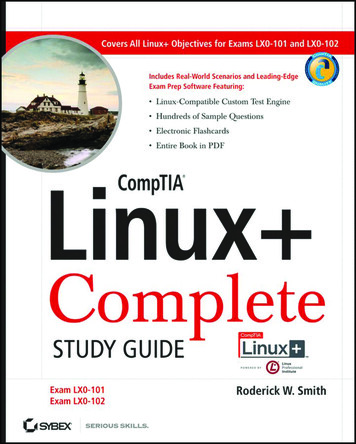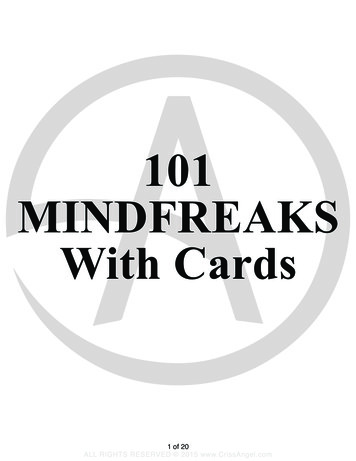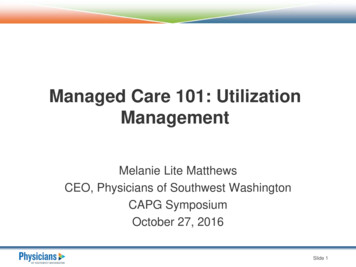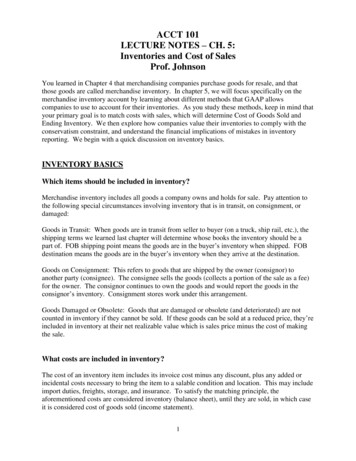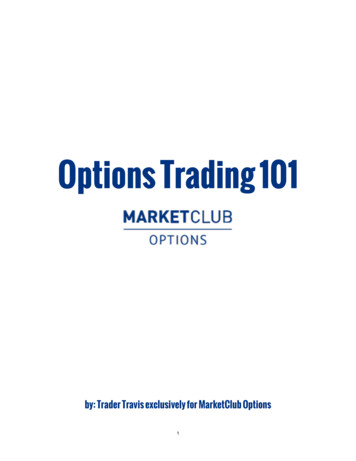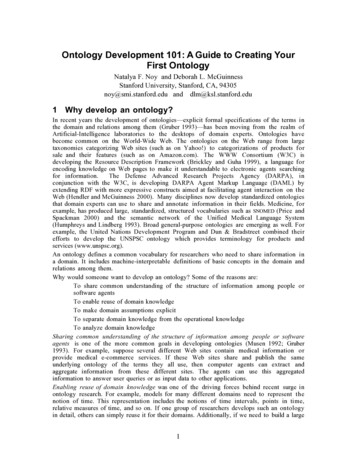
Transcription
Ontology Development 101: A Guide to Creating YourFirst OntologyNatalya F. Noy and Deborah L. McGuinnessStanford University, Stanford, CA, 94305noy@smi.stanford.edu and dlm@ksl.stanford.edu1Why develop an ontology?In recent years the development of ontologies—explicit formal specifications of the terms inthe domain and relations among them (Gruber 1993)—has been moving from the realm ofArtificial-Intelligence laboratories to the desktops of domain experts. Ontologies havebecome common on the World-Wide Web. The ontologies on the Web range from largetaxonomies categorizing Web sites (such as on Yahoo!) to categorizations of products forsale and their features (such as on Amazon.com). The WWW Consortium (W3C) isdeveloping the Resource Description Framework (Brickley and Guha 1999), a language forencoding knowledge on Web pages to make it understandable to electronic agents searchingfor information.The Defense Advanced Research Projects Agency (DARPA), inconjunction with the W3C, is developing DARPA Agent Markup Language (DAML) byextending RDF with more expressive constructs aimed at facilitating agent interaction on theWeb (Hendler and McGuinness 2000). Many disciplines now develop standardized ontologiesthat domain experts can use to share and annotate information in their fields. Medicine, forexample, has produced large, standardized, structured vocabularies such as SNOMED (Price andSpackman 2000) and the semantic network of the Unified Medical Language System(Humphreys and Lindberg 1993). Broad general-purpose ontologies are emerging as well. Forexample, the United Nations Development Program and Dun & Bradstreet combined theirefforts to develop the UNSPSC ontology which provides terminology for products andservices (www.unspsc.org).An ontology defines a common vocabulary for researchers who need to share information ina domain. It includes machine-interpretable definitions of basic concepts in the domain andrelations among them.Why would someone want to develop an ontology? Some of the reasons are: To share common understanding of the structure of information among people orsoftware agents To enable reuse of domain knowledge To make domain assumptions explicit To separate domain knowledge from the operational knowledge To analyze domain knowledgeSharing common understanding of the structure of information among people or softwareagents is one of the more common goals in developing ontologies (Musen 1992; Gruber1993). For example, suppose several different Web sites contain medical information orprovide medical e-commerce services. If these Web sites share and publish the sameunderlying ontology of the terms they all use, then computer agents can extract andaggregate information from these different sites. The agents can use this aggregatedinformation to answer user queries or as input data to other applications.Enabling reuse of domain knowledge was one of the driving forces behind recent surge inontology research. For example, models for many different domains need to represent thenotion of time. This representation includes the notions of time intervals, points in time,relative measures of time, and so on. If one group of researchers develops such an ontologyin detail, others can simply reuse it for their domains. Additionally, if we need to build a large1
ontology, we can integrate several existing ontologies describing portions of the largedomain. We can also reuse a general ontology, such as the UNSPSC ontology, and extend itto describe our domain of interest.Making explicit domain assumptions underlying an implementation makes it possible t ochange these assumptions easily if our knowledge about the domain changes. Hard-codingassumptions about the world in programming-language code makes these assumptions notonly hard to find and understand but also hard to change, in particular for someone withoutprogramming expertise. In addition, explicit specifications of domain knowledge are usefulfor new users who must learn what terms in the domain mean.Separating the domain knowledge from the operational knowledge is another common useof ontologies. We can describe a task of configuring a product from its components accordingto a required specification and implement a program that does this configuration independentof the products and components themselves (McGuinness and Wright 1998). We can thendevelop an ontology of PC-components and characteristics and apply the algorithm t oconfigure made-to-order PCs. We can also use the same algorithm to configure elevators ifwe “feed” an elevator component ontology to it (Rothenfluh et al. 1996).Analyzing domain knowledge is possible once a declarative specification of the terms isavailable. Formal analysis of terms is extremely valuable when both attempting to reuseexisting ontologies and extending them (McGuinness et al. 2000).Often an ontology of the domain is not a goal in itself. Developing an ontology is akin t odefining a set of data and their structure for other programs to use. Problem-solving methods,domain-independent applications, and software agents use ontologies and knowledge basesbuilt from ontologies as data. For example, in this paper we develop an ontology of wine andfood and appropriate combinations of wine with meals. This ontology can then be used as abasis for some applications in a suite of restaurant-managing tools: One application couldcreate wine suggestions for the menu of the day or answer queries of waiters and customers.Another application could analyze an inventory list of a wine cellar and suggest which winecategories to expand and which particular wines to purchase for upcoming menus orcookbooks.About this guideWe build on our experience using Protégé-2000 (Protege 2000), Ontolingua (Ontolingua1997), and Chimaera (Chimaera 2000) as ontology-editing environments. In this guide, weuse Protégé-2000 for our examples.The wine and food example that we use throughout this guide is loosely based on an exampleknowledge base presented in a paper describing CLASSIC—a knowledge-representationsystem based on a description-logics approach (Brachman et al. 1991). The CLASSIC tutorial(McGuinness et al. 1994) has developed this example further. Protégé-2000 and otherframe-based systems describe ontologies declaratively, stating explicitly what the classhierarchy is and to which classes individuals belong.Some ontology-design ideas in this guide originated from the literature on object-orienteddesign (Rumbaugh et al. 1991; Booch et al. 1997). However, ontology development isdifferent from designing classes and relations in object-oriented programming. Objectoriented programming centers primarily around methods on classes—a programmer makesdesign decisions based on the operational properties of a class, whereas an ontology designermakes these decisions based on the structural properties of a class. As a result, a classstructure and relations among classes in an ontology are different from the structure for asimilar domain in an object-oriented program.It is impossible to cover all the issues that an ontology developer may need to grapple withand we are not trying to address all of them in this guide. Instead, we try to provide a startingpoint; an initial guide that would help a new ontology designer to develop ontologies. At the2
end, we suggest places to look for explanations of more complicated structures and designmechanisms if the domain requires them.Finally, there is no single correct ontology-design methodology and we did not attempt t odefine one. The ideas that we present here are the ones that we found useful in our ownontology-development experience. At the end of this guide we suggest a list of references foralternative methodologies.2What is in an ontology?The Artificial-Intelligence literature contains many definitions of an ontology; many ofthese contradict one another. For the purposes of this guide an ontology is a formal explicitdescription of concepts in a domain of discourse (classes (sometimes called concepts)),properties of each concept describing various features and attributes of the concept (slots(sometimes called roles or properties)), and restrictions on slots (facets (sometimes calledrole restrictions)). An ontology together with a set of individual instances of classesconstitutes a knowledge base. In reality, there is a fine line where the ontology ends andthe knowledge base begins.Classes are the focus of most ontologies. Classes describe concepts in the domain. Forexample, a class of wines represents all wines. Specific wines are instances of this class. TheBordeaux wine in the glass in front of you while you read this document is an instance of theclass of Bordeaux wines. A class can have subclasses that represent concepts that are morespecific than the superclass. For example, we can divide the class of all wines into red, white,and rosé wines. Alternatively, we can divide a class of all wines into sparkling and nonsparkling wines.Slots describe properties of classes and instances: Château Lafite RothschildPauillac wine has a full body; it is produced by the Château Lafite Rothschildwinery. We have two slots describing the wine in this example: the slot body with the valuefull and the slot maker with the value Château Lafite Rothschild winery. At theclass level, we can say that instances of the class Wine will have slots describing theirflavor, body, sugar level, the maker of the wine and so on.1All instances of the class Wine, and its subclass Pauillac, have a slot maker the value ofwhich is an instance of the class Winery (Figure 1). All instances of the class Winery have aslot produces that refers to all the wines (instances of the class Wine and its subclasses)that the winery produces.In practical terms, developing an ontology includes: defining classes in the ontology, arranging the classes in a taxonomic (subclass–superclass) hierarchy, defining slots and describing allowed values for these slots, filling in the values for slots for instances.We can then create a knowledge base by defining individual instances of these classes filling inspecific slot value information and additional slot restrictions.1We capitalize class names and start slot names with low-case letters. We also use typewriter font forall terms from the example ontology.3
Figure 1. Some classes, instances, and relations among them in the wine domain. We used blackfor classes and red for instances. Direct links represent slots and internal links such as instance-ofand subclass-of.3A Simple Knowledge-Engineering MethodologyAs we said earlier, there is no one “correct” way or methodology for developing ontologies.Here we discuss general issues to consider and offer one possible process for developing anontology. We describe an iterative approach to ontology development: we start with a roughfirst pass at the ontology. We then revise and refine the evolving ontology and fill in thedetails. Along the way, we discuss the modeling decisions that a designer needs to make, aswell as the pros, cons, and implications of different solutions.First, we would like to emphasize some fundamental rules in ontology design to which we willrefer many times. These rules may seem rather dogmatic. They can help, however, to makedesign decisions in many cases.1) There is no one correct way to model a domain— there are alwaysviable alternatives. The best solution almost always depends on theapplication that you have in mind and the extensions that you anticipate.2) Ontology development is necessarily an iterative process.3) Concepts in the ontology should be close to objects (physical or logical)and relationships in your domain of interest. These are most likely to benouns (objects) or verbs (relationships) in sentences that describe yourdomain.That is, deciding what we are going to use the ontology for, and how detailed or general theontology is going to be will guide many of the modeling decisions down the road. Amongseveral viable alternatives, we will need to determine which one would work better for theprojected task, be more intuitive, more extensible, and more maintainable. We also need t oremember that an ontology is a model of reality of the world and the concepts in theontology must reflect this reality. After we define an initial version of the ontology, we canevaluate and debug it by using it in applications or problem-solving methods or by discussingit with experts in the field, or both. As a result, we will almost certainly need to revise theinitial ontology. This process of iterative design will likely continue through the entirelifecycle of the ontology.4
Step 1. Determine the domain and scope of the ontologyWe suggest starting the development of an ontology by defining its domain and scope. Thatis, answer several basic questions: What is the domain that the ontology will cover? For what we are going to use the ontology? For what types of questions the information in the ontology should provide answers? Who will use and maintain the ontology?The answers to these questions may change during the ontology-design process, but at anygiven time they help limit the scope of the model.Consider the ontology of wine and food that we introduced earlier. Representation of foodand wines is the domain of the ontology. We plan to use this ontology for the applicationsthat suggest good combinations of wines and food.Naturally, the concepts describing different types of wines, main food types, the notion of agood combination of wine and food and a bad combination will figure into our ontology. Atthe same time, it is unlikely that the ontology will include concepts for managing inventoryin a winery or employees in a restaurant even though these concepts are somewhat related t othe notions of wine and food.If the ontology we are designing will be used to assist in natural language processing of articlesin wine magazines, it may be important to include synonyms and part-of-speech informationfor concepts in the ontology. If the ontology will be used to help restaurant customers decidewhich wine to order, we need to include retail-pricing information. If it is used for winebuyers in stocking a wine cellar, wholesale pricing and availability may be necessary. If thepeople who will maintain the ontology describe the domain in a language that is differentfrom the language of the ontology users, we may need to provide the mapping between thelanguages.Competency questions.One of the ways to determine the scope of the ontology is to sketch a list of questions that aknowledge base based on the ontology should be able to answer, competency questions(Gruninger and Fox 1995). These questions will serve as the litmus test later: Does theontology contain enough information to answer these types of questions? Do the answersrequire a particular level of detail or representation of a particular area? These competencyquestions are just a sketch and do not need to be exhaustive.In the wine and food domain, the following are the possible competency questions: Which wine characteristics should I consider when choosing a wine? Is Bordeaux a red or white wine? Does Cabernet Sauvignon go well with seafood? What is the best choice of wine for grilled meat? Which characteristics of a wine affect its appropriateness for a dish? Does a bouquet or body of a specific wine change with vintage year? What were good vintages for Napa Zinfandel?Judging from this list of questions, the ontology will include the information on various winecharacteristics and wine types, vintage years—good and bad ones—classifications of foodsthat matter for choosing an appropriate wine, recommended combinations of wine and food.Step 2. Consider reusing existing ontologiesIt is almost always worth considering what someone else has done and checking if we canrefine and extend existing sources for our particular domain and task. Reusing existing5
ontologies may be a requirement if our system needs to interact with other applications thathave already committed to particular ontologies or controlled vocabularies. Many ontologiesare already available in electronic form and can be imported into an ontology-developmentenvironment that you are using. The formalism in which an ontology is expressed often doesnot matter, since many knowledge-representation systems can import and export ontologies.Even if a knowledge-representation system cannot work directly with a particular formalism,the task of translating an ontology from one formalism to another is usually not a difficultone.There are libraries of reusable ontologies on the Web and in the literature. For example, wecan use the Ontolingua ontology library (http://www.ksl.stanford.edu/software/ontolingua/) orthe DAML ontology library (http://www.daml.org/ontologies/). There are also a number ofpublicly available commercial ontologies (e.g., UNSPSC (www.unspsc.org), RosettaNet(www.rosettanet.org), DMOZ (www.dmoz.org)).For example, a knowledge base of French wines may already exist. If we can import thisknowledge base and the ontology on which it is based, we will have not only the classificationof French wines but also the first pass at the classification of wine characteristics used t odistinguish and describe the wines. Lists of wine properties may already be available fromcommercial Web sites such as www.wines.com that customers consider use to buy wines.For this guide however we will assume that no relevant ontologies already exist and startdeveloping the ontology from scratch.Step 3. Enumerate important terms in the ontologyIt is useful to write down a list of all terms we would like either to make statements about orto explain to a user. What are the terms we would like to talk about? What properties dothose terms have? What would we like to say about those terms? For example, importantwine-related terms will include wine, grape, winery, location, a wine’s color,body, flavor and sugar content; different types of food, such as fish and redmeat; subtypes of wine such as white wine, and so on. Initially, it is important to get acomprehensive list of terms without worrying about overlap between concepts theyrepresent, relations among the terms, or any properties that the concepts may have, orwhether the concepts are classes or slots.The next two steps—developing the class hierarchy and defining properties of concepts(slots)—are closely intertwined. It is hard to do one of them first and then do the other.Typically, we create a few definitions of the concepts in the hierarchy and then continue bydescribing properties of these concepts and so on. These two steps are also the mostimportant steps in the ontology-design process. We will describe them here briefly and thenspend the next two sections discussing the more complicated issues that need to beconsidered, common pitfalls, decisions to make, and so on.Step 4. Define the classes and the class hierarchyThere are several possible approaches in developing a class hierarchy (Uschold andGruninger 1996): A top-down development process starts with the definition of the most generalconcepts in the domain and subsequent specialization of the concepts. For example,we can start with creating classes for the general concepts of Wine and Food. Thenwe specialize the Wine class by creating some of its subclasses: White wine, Redwine, Rosé wine. We can further categorize the Red wine class, for example,into Syrah, Red Burgundy, Cabernet Sauvignon, and so on.6
A bottom-up development process starts with the definition of the most specificclasses, the leaves of the hierarchy, with subsequent grouping of these classes intomore general concepts. For example, we start by defining classes for Pauillac andMargaux wines. We then create a common superclass for these twoclasses—Medoc—which in turn is a subclass of Bordeaux. A combination development process is a combination of the top-down and bottomup approaches: We define the more salient concepts first and then generalize andspecialize them appropriately. We might start with a few top-level concepts such asWine, and a few specific concepts, such as Margaux . We can then relate them to amiddle-level concept, such as Medoc. Then we may want to generate all of theregional wine classes from France, thereby generating a number of middle-levelconcepts.Figure 2 shows a possible breakdown among the different levels of generality. Figure 2. The different levels of the Wine taxonomy: Wine is the most general concept. Red wine,White wine, and Rosé wine are general top level concepts. Pauillac and Margaux are themost specific classes in the hierarchy (or the bottom level concepts).None of these three methods is inherently better than any of the others. The approach t otake depends strongly on the personal view of the domain. If a developer has a systematictop-down view of the domain, then it may be easier to use the top-down approach. Thecombination approach is often the easiest for many ontology developers, since the concepts“in the middle” tend to be the more descriptive concepts in the domain (Rosch 1978).If you tend to think of wines by distinguishing the most general classification first, then thetop-down approach may work better for you. If you’d rather start by getting grounded withspecific examples, the bottom-up approach may be more appropriate.Whichever approach we choose, we usually start by defining classes. From the list created inStep 3, we select the terms that describe objects having independent existence rather thanterms that describe these objects. These terms will be classes in the ontology and will become7
anchors in the class hierarchy.2 We organize the classes into a hierarchical taxonomy byasking if by being an instance of one class, the object will necessarily (i.e., by definition) bean instance of some other class.If a class A is a superclass of class B, then every instance of B is also aninstance of AIn other words, the class B represents a concept that is a “kind of” A.For example, every Pinot Noir wine is necessarily a red wine. Therefore the Pinot Noirclass is a subclass of the Red Wine class.Figure 2 shows a part of the class hierarchy for the Wine ontology. Section 4 contains adetailed discussion of things to look for when defining a class hierarchy.Figure 3. The slots for the class Wine and the facets for these slots. The “I” icon next to the makerslot indicates that the slot has an inverse (Section 5.1)Step 5. Define the properties of classes—slotsThe classes alone will not provide enough information to answer the competency questionsfrom Step 1. Once we have defined some of the classes, we must describe the internalstructure of concepts.We have already selected classes from the list of terms we created in Step 3. Most of theremaining terms are likely to be properties of these classes. These terms include, forexample, a wine’s color, body, flavor and sugar content and location of awinery.For each property in the list, we must determine which class it describes. These propertiesbecome slots attached to classes. Thus, the Wine class will have the following slots: color,body, flavor, and sugar. And the class Winery will have a location slot.In general, there are several types of object properties that can become slots in an ontology: “intrinsic” properties such as the flavor of a wine; “extrinsic” properties such as a wine’s name, and area it comes from; parts, if the object is structured; these can be both physical and abstract “parts” (e.g.,the courses of a meal) relationships to other individuals; these are the relationships between individualmembers of the class and other items (e.g., the maker of a wine, representing arelationship between a wine and a winery, and the grape the wine is made from.)Thus, in addition to the properties we have identified earlier, we need to add the following2We can also view classes as unary predicates—questions that have one argument. For example, “Is thisobject a wine?” Unary predicates (or classes) contrast with binary predicates (or slots)—questions that havetwo arguments. For example, “Is the flavor of this object strong?” “What is the flavor of this object?”8
slots to the Wine class: name, area, maker, grape. Figure 3 shows the slots for the classWine.All subclasses of a class inherit the slot of that class. For example, all the slots of the classWine will be inherited to all subclasses of Wine, including Red Wine and White Wine.We will add an additional slot, tannin level (low, moderate, or high), to the RedWine class. The tannin level slot will be inherited by all the classes representing redwines (such as Bordeaux and Beaujolais).A slot should be attached at the most general class that can have that property. For instance,body and color of a wine should be attached at the class Wine, since it is the most generalclass whose instances will have body and color.Step 6. Define the facets of the slotsSlots can have different facets describing the value type, allowed values, the number of thevalues (cardinality), and other features of the values the slot can take. For example, the valueof a name slot (as in “the name of a wine”) is one string. That is, name is a slot with valuetype String. A slot produces (as in “a winery produces these wines”) can have multiplevalues and the values are instances of the class Wine. That is, produces is a slot with valuetype Instance with Wine as allowed class.We will now describe several common facets.Slot cardinalitySlot cardinality defines how many values a slot can have. Some systems distinguish onlybetween single cardinality (allowing at most one value) and multiple cardinality (allowing anynumber of values). A body of a wine will be a single cardinality slot (a wine can have onlyone body). Wines produced by a particular winery fill in a multiple-cardinality slotproduces for a Winery class.Some systems allow specification of a minimum and maximum cardinality to describe thenumber of slot values more precisely. Minimum cardinality of N means that a slot must haveat least N values. For example, the grape slot of a Wine has a minimum cardinality of 1:each wine is made of at least one variety of grape. Maximum cardinality of M means that aslot can have at most M values. The maximum cardinality for the grape slot for singlevarietal wines is 1: these wines are made from only one variety of grape. Sometimes it maybe useful to set the maximum cardinality to 0. This setting would indicate that the slotcannot have any values for a particular subclass.Slot-value typeA value-type facet describes what types of values can fill in the slot. Here is a list of the morecommon value types: String is the simplest value type which is used for slots such as name: the value is asimple string Number (sometimes more specific value types of Float and Integer are used)describes slots with numeric values. For example, a price of a wine can have a valuetype Float Boolean slots are simple yes–no flags. For example, if we choose not to representsparkling wines as a separate class, whether or not a wine is sparkling can berepresented as a value of a Boolean slot: if the value is “true” (“yes”) the wine issparkling and if the value is “false” (“no”) the wine is not a sparkling one. Enumerated slots specify a list of specific allowed values for the slot. For example,we can specify that the flavor slot can take on one of the three possible values:9
strong, moderate, and delicate. In Protégé-2000 the enumerated slots are oftype Symbol. Instance-type slots allow definition of relationships between individuals. Slots withvalue type Instance must also define a list of allowed classes from which the instancescan come. For example, a slot produces for the class Winery may have instancesof the class Wine as its values.3Figure 4 shows a definition of the slot produces at the class Winery.Figure 4. The definition of a slot produces that describes the wines produced by a winery. Theslot has cardinality multiple, value type Instance, and the class Wine as the allowed class for itsvalues.Domain and range of a slotAllowed classes for slots of type Instance are often called a range of a slot. In the examplein Figure 4 the class Wine is the range of the produces slot. Some systems allowrestricting the range of a slot when the slot is attached for a particular class.The classes to which a slot is attached or a classes which property a slot describes, are calledthe domain of the slot. The Winery class is the domain of the produces slot. In thesystems where we attach slots to classes, the classes to which the slot is attached usuallyconstitute the domain of that slot. There is no need to specify the domain separately.The basic rules for determining a domain and a range of a slot are similar:When defining a domain or a range for a slot, find the most general classesor class that can be respectively the domain or the range for the slots .On the other hand, do not define a domain and range that is overlygeneral: all the classes in the domain of a slot should be described by theslot and instances of all the classes in the range of a slot should be potentialfillers for the slot. Do not choose an overly general class for range (i.e.,one would not want to make the range THING) but one would want tochoose a class that will cover all fillersInstead of listing all possible subclasses of the Wine class for the range of the produces3Some systems just specify value type with a class instead of requiring a special statement of instancetype slots.10
slot, just list Wine. At the same time, we do not want to specify the range of the slot asTHING—the most general class in an ontology.In more specific terms:If a list of classes defining a range or a domain of a slot includes a classand its subclass, remove the subclass.If the range of the slot contains both the Wine class and the Red Wine class, we canremove the Red Win
We build on our experience using Protégé-2000 (Protege 2000), Ontolingua (Ontolingua 1997), and Chimaera (Chimaera 2000) as ontology-editing environments. In this guide, we use Protégé-2000 for our examples. The wine and food example that we use throughout this guide is loosely ba
